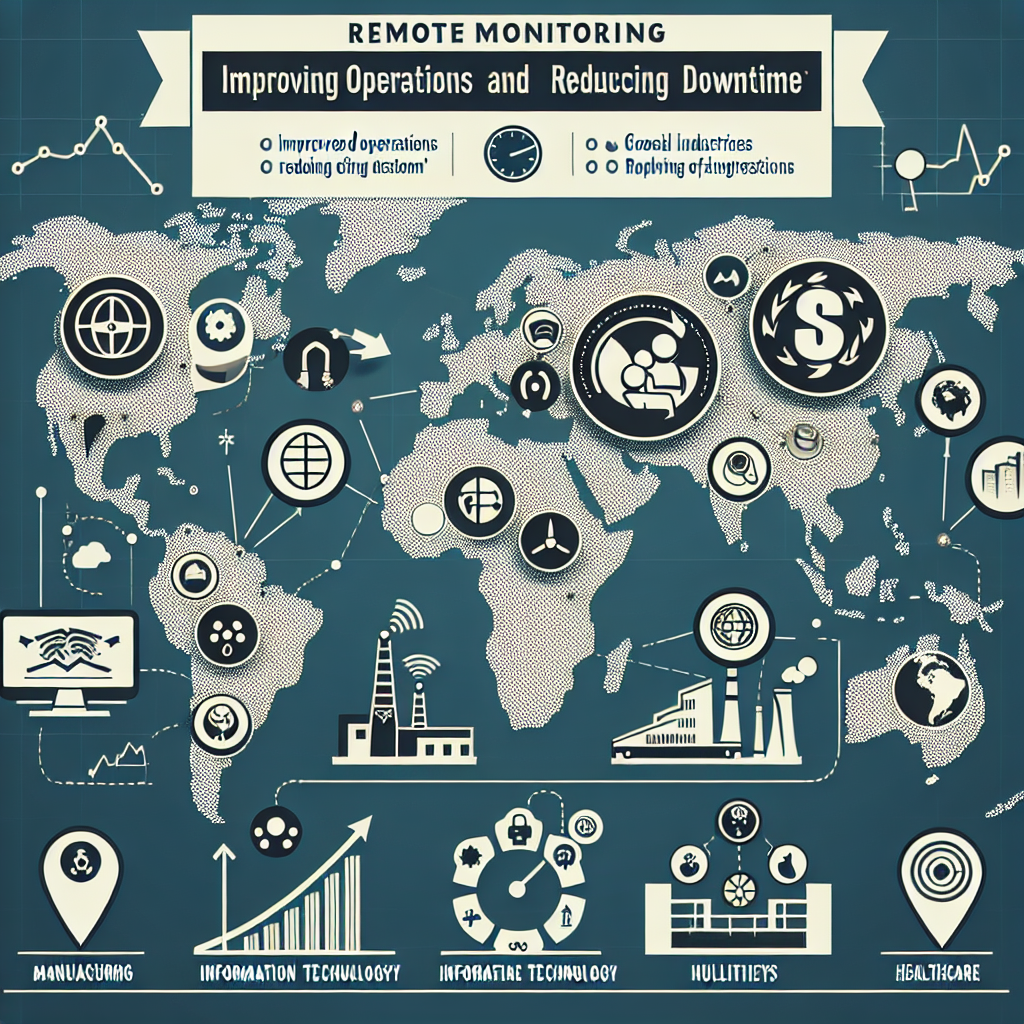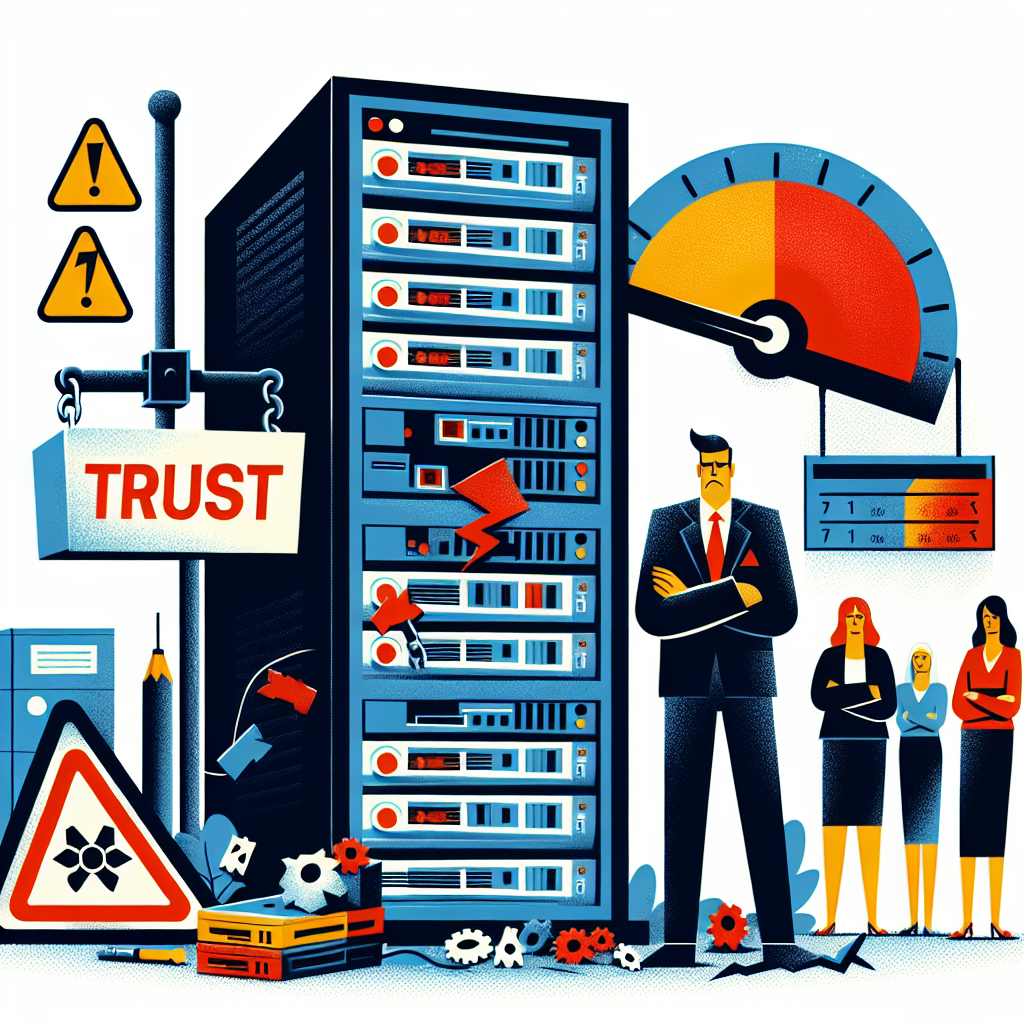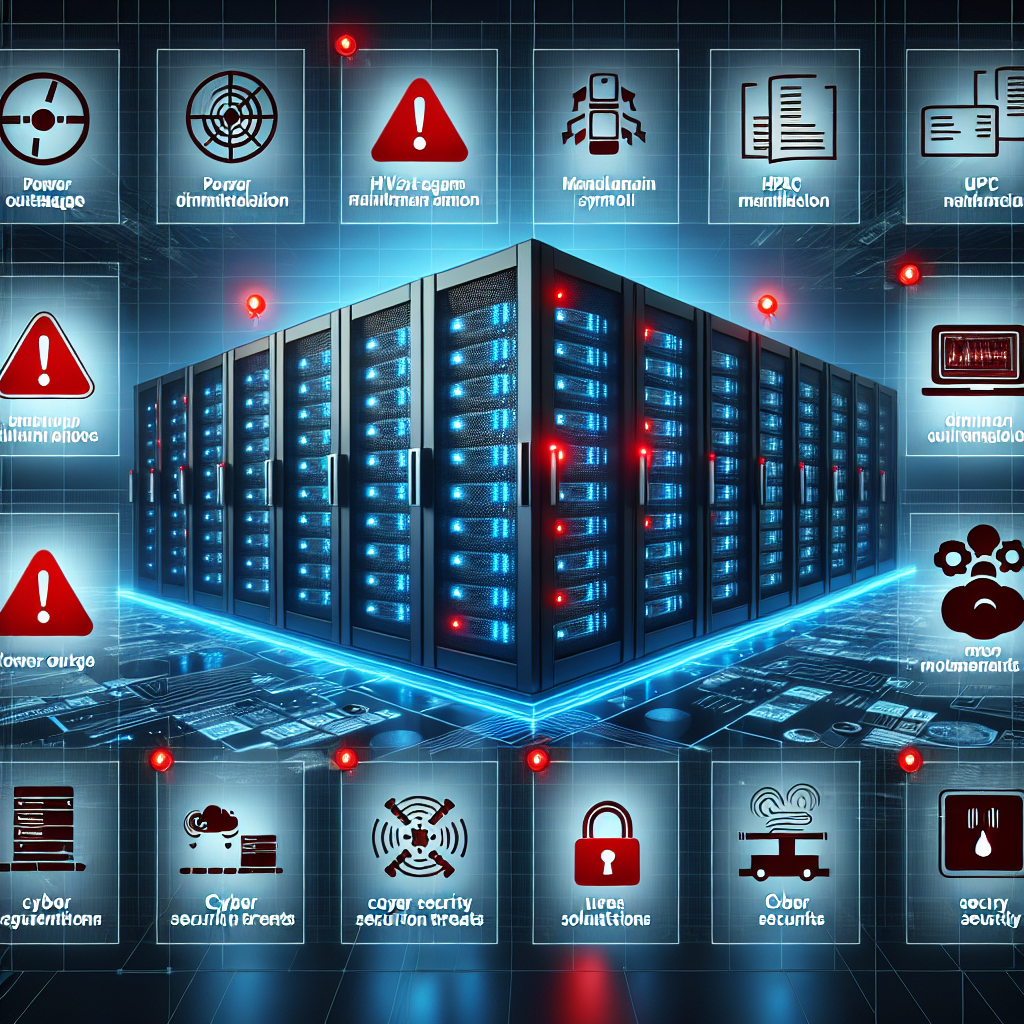Your cart is currently empty!
Tag: Downtime

Remote Monitoring: Improving Operations and Reducing Downtime
Remote monitoring is a crucial tool for businesses looking to improve their operations and reduce downtime. By utilizing remote monitoring technology, businesses can keep a close eye on their equipment and systems from a distance, allowing them to detect issues early on and prevent costly breakdowns.One of the key benefits of remote monitoring is its ability to provide real-time data on the performance of equipment and systems. This data can be used to identify trends and patterns that may indicate potential issues before they escalate into major problems. By catching these issues early, businesses can take proactive measures to address them, preventing costly downtime and repairs.
Remote monitoring also allows businesses to monitor their equipment and systems from anywhere, at any time. This means that even if a business owner or operator is not on-site, they can still keep tabs on their operations and address any issues that may arise. This level of flexibility and control can be especially valuable for businesses with multiple locations or complex systems that require constant monitoring.
In addition to improving operations and reducing downtime, remote monitoring can also lead to cost savings for businesses. By catching issues early and preventing breakdowns, businesses can avoid costly repairs and replacements, as well as the loss of productivity that comes with equipment downtime. Remote monitoring can also help businesses optimize their operations, leading to increased efficiency and reduced waste.
Overall, remote monitoring is a valuable tool for businesses looking to improve their operations and reduce downtime. By providing real-time data on equipment performance, allowing for remote monitoring from anywhere, and leading to cost savings, remote monitoring can help businesses stay ahead of potential issues and keep their operations running smoothly. By investing in remote monitoring technology, businesses can ensure that they are proactive in maintaining their equipment and systems, ultimately leading to increased productivity and profitability.

How Proactive Network Management Can Prevent Downtime and Improve Productivity
In today’s fast-paced business environment, network downtime can be a major hindrance to productivity. When a network goes down, it can bring operations to a screeching halt, causing delays, frustration, and financial losses. That’s why proactive network management is essential in preventing downtime and ensuring that your business runs smoothly.Proactive network management involves actively monitoring and maintaining your network infrastructure to identify and address potential issues before they escalate into major problems. By taking a proactive approach to network management, businesses can prevent downtime, improve productivity, and ultimately save time and money.
One of the key benefits of proactive network management is the ability to identify and address potential issues before they impact operations. By regularly monitoring network performance and conducting routine maintenance, IT teams can detect issues such as network congestion, hardware failures, or security vulnerabilities early on and take proactive steps to resolve them. This proactive approach helps to prevent downtime and minimize disruptions to business operations.
In addition to preventing downtime, proactive network management can also improve productivity by optimizing network performance. By monitoring network traffic, identifying bottlenecks, and implementing performance enhancements, IT teams can ensure that the network is running smoothly and efficiently. This can help to improve the speed and reliability of network connections, allowing employees to work more efficiently and effectively.
Furthermore, proactive network management can also enhance security by identifying and addressing potential vulnerabilities before they can be exploited by cyber attackers. By regularly updating software, implementing security patches, and conducting security audits, IT teams can strengthen the network’s defenses and protect sensitive data from unauthorized access.
Overall, proactive network management is a critical component of a successful IT strategy. By taking a proactive approach to network management, businesses can prevent downtime, improve productivity, and enhance security. Investing in proactive network management can help businesses to operate more efficiently, reduce costs, and stay ahead of potential issues before they become major problems.

How Proactive Maintenance Can Reduce Downtime and Increase Productivity
Proactive Maintenance: The Key to Minimizing Downtime and Maximizing ProductivityIn any industrial setting, downtime can be a significant source of stress and financial loss. When machinery or equipment breaks down unexpectedly, production grinds to a halt, deadlines are missed, and revenue is lost. This is why proactive maintenance is crucial for businesses looking to minimize downtime and maximize productivity.
Proactive maintenance is a preventive approach to maintenance that focuses on identifying and addressing potential issues before they lead to equipment failure. By conducting regular inspections, monitoring performance metrics, and performing routine maintenance tasks, businesses can avoid costly breakdowns and keep their operations running smoothly.
One of the main benefits of proactive maintenance is the reduction of downtime. By addressing issues before they escalate, businesses can avoid unexpected breakdowns that can bring production to a standstill. This not only saves time and money, but also helps businesses meet deadlines and maintain a competitive edge in the market.
In addition to reducing downtime, proactive maintenance can also increase productivity. When equipment is well-maintained and operating efficiently, it can perform at its peak level, leading to higher output and improved overall performance. This can result in increased profitability and a stronger bottom line for businesses.
Furthermore, proactive maintenance can also extend the lifespan of equipment, reducing the need for costly repairs or replacements. By regularly servicing machinery and addressing issues early on, businesses can prolong the life of their assets and maximize their return on investment.
Overall, proactive maintenance is a crucial component of any successful business operation. By taking a proactive approach to maintenance, businesses can minimize downtime, increase productivity, and reduce costs in the long run. Investing in proactive maintenance can lead to a more efficient and profitable operation, ensuring success in today’s competitive business landscape.

The Cost of Downtime: How Data Center Reactive Maintenance Can Minimize Risks
Data centers are the backbone of the modern digital world, housing the servers and equipment that power everything from small businesses to large corporations. However, like any complex system, data centers are not immune to problems and downtime. In fact, downtime can be incredibly costly for businesses, both in terms of lost revenue and damage to their reputation.The cost of downtime can vary greatly depending on the size and nature of the business, but it can easily run into the thousands or even millions of dollars per hour. In addition to the immediate financial impact, downtime can also have long-term consequences, such as lost customers and damage to a company’s brand.
One way to minimize the risks of downtime is through proactive maintenance of data center equipment. By regularly inspecting and maintaining equipment, businesses can identify and address potential issues before they escalate into major problems. This proactive approach can help prevent unexpected outages and keep systems running smoothly.
However, even with proactive maintenance, it’s impossible to completely eliminate the risk of downtime. That’s where reactive maintenance comes in. Reactive maintenance involves responding to issues as they arise, rather than proactively addressing them. While reactive maintenance is not ideal, it can be a necessary part of a comprehensive maintenance strategy.
The key to effective reactive maintenance is to respond quickly and efficiently to issues. This requires having a team of skilled technicians on hand who can quickly diagnose and address problems. It also requires having access to spare parts and equipment, so that repairs can be made as quickly as possible.
While reactive maintenance can help minimize the risks of downtime, it’s not a perfect solution. It can be costly, both in terms of the actual repairs and the lost revenue from downtime. That’s why businesses should strive to strike a balance between proactive and reactive maintenance, ensuring that they are properly prepared for any eventuality.
In conclusion, the cost of downtime can be significant for businesses, both financially and in terms of reputation. By implementing a comprehensive maintenance strategy that includes both proactive and reactive maintenance, businesses can minimize the risks of downtime and keep their data centers running smoothly. This can help ensure that they are able to meet the demands of their customers and maintain a competitive edge in the digital world.

Measuring the True Cost of Data Center Downtime: A Closer Look at Financial and Operational Losses
Data center downtime can have a significant impact on a company’s bottom line, both financially and operationally. In today’s digital age, data centers play a crucial role in storing and processing critical business information. When a data center experiences downtime, it can disrupt operations, lead to lost revenue, and damage a company’s reputation.To accurately measure the true cost of data center downtime, it is important to consider both the financial and operational losses that can occur. Financial losses can include lost revenue, penalties for breaching service level agreements, and the cost of repairing any damage caused by the downtime. Operational losses can include decreased productivity, loss of customer trust, and damage to a company’s reputation.
One of the most significant financial costs of data center downtime is lost revenue. When a data center goes offline, businesses are unable to access critical information and services, leading to lost sales and potential customers. Additionally, companies may be subject to penalties for failing to meet service level agreements with customers, which can further impact their bottom line.
Operational losses can also have a significant impact on a company’s overall performance. When a data center experiences downtime, employees may be unable to access the information and tools they need to perform their jobs effectively. This can lead to decreased productivity, missed deadlines, and increased stress among employees. Additionally, customers may lose trust in a company that cannot keep their data secure and accessible, leading to long-term damage to a company’s reputation.
In order to mitigate the impact of data center downtime, companies should invest in robust backup and disaster recovery solutions. These solutions can help minimize the financial and operational losses associated with downtime by ensuring that critical data and services are quickly restored in the event of an outage. Additionally, companies should regularly test their backup and disaster recovery plans to ensure they are effective in a real-world scenario.
By taking proactive measures to prevent and mitigate data center downtime, companies can minimize the financial and operational costs associated with outages. By accurately measuring the true cost of downtime, companies can make informed decisions about how to best protect their business from the potentially devastating effects of data center outages.

Maximizing Efficiency and Minimizing Downtime: A Guide to Data Center Problem Management
In today’s digital age, data centers play a crucial role in the storage, processing, and management of vast amounts of data. With the increasing reliance on technology and the exponential growth of data, the need for efficient data center operations has never been more critical. However, maintaining optimal performance and minimizing downtime in a data center can be a challenging task, especially with the complexity of modern IT infrastructure.To ensure maximum efficiency and minimize downtime, data center operators must implement effective problem management strategies. By identifying and addressing issues proactively, data center managers can prevent disruptions, improve performance, and ultimately enhance the overall reliability of their infrastructure.
One key aspect of effective problem management is monitoring and analyzing data center performance metrics in real-time. By closely monitoring key performance indicators such as server utilization, network traffic, and storage capacity, operators can quickly identify potential issues and take corrective action before they escalate into major problems. Utilizing advanced monitoring tools and analytics software can provide valuable insights into the health of the data center and help operators make informed decisions to optimize performance.
In addition to proactive monitoring, data center operators should also establish clear incident response procedures to address any issues that may arise. By creating a structured and well-defined process for identifying, categorizing, and resolving problems, operators can minimize downtime and ensure a swift resolution to any disruptions. This includes establishing a centralized incident management system, assigning roles and responsibilities to team members, and implementing escalation procedures for complex issues that require additional expertise.
Furthermore, data center operators should prioritize regular maintenance and preventive maintenance practices to prevent potential issues before they occur. This includes performing routine equipment checks, updating software and firmware, and conducting regular performance tuning to ensure optimal operation. By implementing a proactive maintenance schedule, operators can reduce the risk of downtime and prolong the lifespan of their equipment.
In conclusion, maximizing efficiency and minimizing downtime in a data center requires a proactive and strategic approach to problem management. By monitoring performance metrics, establishing incident response procedures, and prioritizing preventive maintenance, data center operators can optimize performance, enhance reliability, and ensure uninterrupted operation. By investing in effective problem management strategies, data centers can maintain their competitive edge in today’s fast-paced digital landscape.

Minimizing Risks and Downtime with Data Center Change Management
In today’s fast-paced business environment, data centers play a crucial role in ensuring the smooth operation of an organization’s IT infrastructure. With the increasing reliance on technology, any downtime or disruption in the data center can have a significant impact on the business, leading to lost revenue, decreased productivity, and damaged reputation.To mitigate the risks associated with data center changes, organizations need to implement effective change management processes. By carefully planning and executing changes in the data center, businesses can minimize downtime and ensure the stability and reliability of their IT systems.
One key aspect of data center change management is thorough planning. Before making any changes to the data center, it is essential to assess the potential impact on the existing infrastructure and systems. This includes identifying potential risks and developing a detailed plan to mitigate them. By understanding the potential challenges and preparing accordingly, organizations can minimize the likelihood of unplanned downtime.
Another critical component of data center change management is communication. It is essential to keep all stakeholders informed about upcoming changes and their potential impact. This includes IT staff, business leaders, and end-users who may be affected by the changes. By maintaining open and transparent communication throughout the change process, organizations can ensure that everyone is on the same page and can work together to minimize disruptions.
Testing is also a crucial part of data center change management. Before implementing any changes, it is essential to thoroughly test them in a controlled environment to identify any potential issues or conflicts. By conducting thorough testing, organizations can catch any problems early on and address them before they cause downtime or disruption in the production environment.
Monitoring is another key element of data center change management. By closely monitoring the data center before, during, and after changes are implemented, organizations can quickly identify and address any issues that arise. This proactive approach can help prevent downtime and ensure the smooth operation of the data center.
In conclusion, minimizing risks and downtime with data center change management is essential for ensuring the stability and reliability of an organization’s IT infrastructure. By carefully planning, communicating, testing, and monitoring changes, businesses can mitigate the risks associated with data center changes and maintain the smooth operation of their IT systems. Investing time and resources in effective change management processes can help organizations avoid costly disruptions and ensure the continued success of their business.

The Impact of Data Center Downtime on Customer Trust and Brand Reputation
Data centers are the backbone of modern businesses, providing the infrastructure necessary to store and process vast amounts of data. However, when these data centers experience downtime, the consequences can be severe. Not only does downtime result in lost revenue and productivity, but it can also have a significant impact on customer trust and brand reputation.When a data center goes down, it can disrupt essential services and operations, leaving customers unable to access their data or services. This can lead to frustration and dissatisfaction among customers, who may choose to take their business elsewhere in search of a more reliable service provider. In fact, studies have shown that downtime can have a lasting impact on customer loyalty, with many customers citing poor service reliability as a key reason for switching to a competitor.
In addition to the immediate loss of revenue and customers, downtime can also have a long-term impact on a company’s brand reputation. In today’s digital age, where consumers rely heavily on technology for everyday tasks, a company’s ability to provide reliable and secure services is crucial to maintaining a positive brand image. When a data center experiences downtime, it can erode customer trust and confidence in the company’s ability to deliver on its promises.
Furthermore, downtime can also have a ripple effect on a company’s overall reputation, as negative experiences are often shared on social media and review platforms. This can further damage a company’s credibility and make it difficult to attract new customers in the future.
To mitigate the impact of data center downtime on customer trust and brand reputation, companies must prioritize proactive measures to prevent downtime and ensure the reliability of their data center infrastructure. This includes implementing redundant systems, investing in regular maintenance and monitoring, and having a comprehensive disaster recovery plan in place.
In conclusion, the impact of data center downtime on customer trust and brand reputation cannot be underestimated. Companies must take proactive steps to prevent downtime and ensure the reliability of their data center infrastructure in order to maintain customer loyalty and protect their brand image in today’s competitive market.

Maximizing Efficiency and Minimizing Downtime: A Guide to Data Center Lifecycle Management
In today’s digital age, data centers are the backbone of virtually every organization. These facilities house the critical infrastructure that supports the storage, processing, and delivery of data and applications. With the increasing reliance on technology for everyday operations, maximizing efficiency and minimizing downtime in data centers has become more important than ever.Data center lifecycle management is the process of strategically planning, designing, implementing, and maintaining a data center to ensure optimal performance and reliability throughout its lifespan. By following best practices in data center lifecycle management, organizations can minimize downtime, reduce costs, and improve overall efficiency.
One key aspect of data center lifecycle management is regular maintenance and monitoring. Data centers are complex environments with multiple components that need to be regularly inspected, cleaned, and updated to ensure optimal performance. By implementing a proactive maintenance schedule, organizations can identify and address potential issues before they escalate into major problems that could lead to downtime.
Another important aspect of data center lifecycle management is capacity planning. As organizations grow and their data needs increase, it’s crucial to have a scalable infrastructure in place to accommodate this growth. By regularly assessing capacity requirements and planning for future expansion, organizations can avoid overloading their data center and ensure that it can continue to meet their needs.
In addition to maintenance and capacity planning, organizations can also improve efficiency and minimize downtime by implementing energy-efficient technologies and practices. Data centers are notorious for their high energy consumption, but by using energy-efficient equipment, implementing cooling strategies, and consolidating servers, organizations can reduce their carbon footprint and lower their operating costs.
Furthermore, organizations can also leverage automation and monitoring tools to streamline data center operations and quickly identify and resolve issues. By implementing automated alerts, predictive analytics, and real-time monitoring, organizations can proactively manage their data center infrastructure and minimize the risk of downtime.
In conclusion, maximizing efficiency and minimizing downtime in data centers is crucial for maintaining the reliability and performance of critical business operations. By following best practices in data center lifecycle management, organizations can ensure that their data centers operate at peak efficiency, reduce costs, and mitigate the risk of downtime. Investing in regular maintenance, capacity planning, energy-efficient technologies, and automation tools will not only help organizations optimize their data center operations but also drive business success in the digital age.

Understanding the Causes of Data Center Downtime and How to Mitigate Them
Data centers are the backbone of modern businesses, providing the infrastructure necessary for storing, processing, and distributing data. However, despite their critical importance, data centers are vulnerable to downtime, which can have severe consequences for businesses, including lost revenue, damaged reputation, and decreased productivity. Understanding the causes of data center downtime is the first step in mitigating these risks.One of the most common causes of data center downtime is power failure. Power outages can occur due to a variety of reasons, including grid failures, equipment malfunctions, and severe weather events. To mitigate the risk of power failure, data centers should have backup power systems in place, such as uninterruptible power supply (UPS) units and generators. These systems can provide emergency power to critical equipment during outages, ensuring that operations can continue uninterrupted.
Another common cause of data center downtime is cooling system failure. Data centers generate a significant amount of heat due to the constant operation of servers and other equipment. Cooling systems are essential for maintaining optimal temperatures within the data center and preventing equipment from overheating. To mitigate the risk of cooling system failure, data centers should have redundant cooling systems in place and regularly maintain and test these systems to ensure they are functioning properly.
Human error is another significant cause of data center downtime. Mistakes made by employees, such as accidentally unplugging equipment or misconfiguring systems, can lead to downtime and potential data loss. To mitigate the risk of human error, data centers should invest in training programs for employees and implement strict protocols for handling equipment and making changes to systems. Additionally, automation tools can help reduce the likelihood of human error by automating routine tasks and minimizing manual intervention.
Natural disasters, such as earthquakes, floods, and hurricanes, can also cause data center downtime. While it may be impossible to prevent natural disasters from occurring, data centers can mitigate the impact of these events by implementing disaster recovery and business continuity plans. These plans should outline procedures for quickly restoring operations in the event of a disaster, including data backup and recovery strategies, alternative workspaces, and communication protocols.
In conclusion, data center downtime can have severe consequences for businesses, but by understanding the causes of downtime and implementing mitigation strategies, data centers can minimize the risk of disruption. By investing in backup power systems, redundant cooling systems, employee training, and disaster recovery plans, data centers can ensure that they are prepared to handle unexpected events and maintain operations without interruption.
